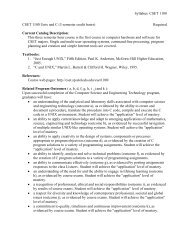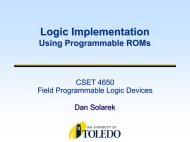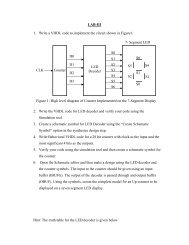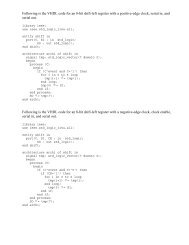Programmable Logic and Application Specific Integrated Circuits
Programmable Logic and Application Specific Integrated Circuits
Programmable Logic and Application Specific Integrated Circuits
You also want an ePaper? Increase the reach of your titles
YUMPU automatically turns print PDFs into web optimized ePapers that Google loves.
area impact is not acute because of the die size required to accommodate the I/O pin requirements.<br />
In a typical ASIC design, the cost of the silicon is typically only 20 to 30% of the manufacturing<br />
cost of the delivered chip. The test costs <strong>and</strong> the cost of the high pin-count package easily exceed<br />
the cost to produce the silicon. Thus, an area impact of 15% may actually only increase the<br />
manufacturing cost of the delivered ASIC by 8% or less. 40 More significantly, the use of a<br />
structured test discipline can result in a reduction in time-to-market of three to six months. This<br />
can be worth millions of dollars in increased sales, easily negating the increased cost of silicon;<br />
without even considering the money saved on reduced system test development <strong>and</strong> debug time.<br />
1. Structured Design for Testability: Scan Design<br />
The structured design for testability approach is based on the concept that any sequential<br />
network can be represented by: 1.) a combinational logic network with primary inputs <strong>and</strong><br />
primary outputs, <strong>and</strong> 2.) memory elements whose inputs are fed by the combinational logic <strong>and</strong><br />
whose outputs feed back into the combinational logic. 39 The key to the success of this technique is<br />
to find an efficient means to control <strong>and</strong> observe the latches (memory elements). The most<br />
common method is to incorporate a shift register (scan) mode into all on-chip memory elements<br />
that allows test input data to be shifted into the memory elements <strong>and</strong> test results to be shifted out.<br />
This scan technique has many names: NEC calls it Scan Path; Sperry Computer Systems called it<br />
Scan/Set <strong>Logic</strong>; Honeywell Inc. calls it Synchronous Scan Design (SSD), <strong>and</strong> IBM calls it Level<br />
Sensitive Scan Design (LSSD). 39 These scan techniques are frequently used in conjunction with a<br />
st<strong>and</strong>ardized test bus interface such as the IEEE 1149.1 Boundary Scan st<strong>and</strong>ard, <strong>and</strong> vary<br />
somewhat with regard to the specific gate level implementation, clocking scheme, <strong>and</strong><br />
corresponding area overhead. 41 42 In order to provide a concrete example of a structured design<br />
for testability technique, the LSSD approach will be briefly described.<br />
A logic subsystem is said to be “Level Sensitive” when the steady-state response to any<br />
allowed input state change is independent of the circuit <strong>and</strong> wiring delays within the subsystem.<br />
Also, if an input state change involves the changing of more than one input signal, then the response<br />
must be independent of the order in which the signals change. Steady state response is the final<br />
value of all logic gate outputs after all change activity has terminated. 43 “Scan Design” refers to<br />
the requirement that all sub-system memory be contained in latches. These latches interconnect to<br />
form a shift register, <strong>and</strong> data can be scanned in to or out of the shift register to control <strong>and</strong>/or<br />
observe the subsystem state.<br />
The basic shift register building block is a polarity hold Shift Register Latch (SRL), shown<br />
in Figure 23. The SRL uses three clocks: C (the system clock); A (a shift clock); <strong>and</strong> B (another<br />
shift clock). System data is presented to the D (data) input, <strong>and</strong> test scan data is presented to the I<br />
(scan) input. During normal system operation the C clock is used to clock data into the L1 stage,<br />
the B clock transfers data from L1 into L2, <strong>and</strong> the A clock is inactive. The A clock is used in<br />
conjunction with the B clock during the test mode. Scan-in data (I) from the L2 output of another<br />
SRL (or from a primary input pin) is latched into L1 by the A clock. By cycling the A <strong>and</strong> B<br />
clocks, data is serially shifted through the scan path from the scan-in (I) terminal to the scan out<br />
terminal.<br />
48
















